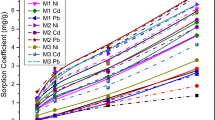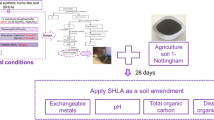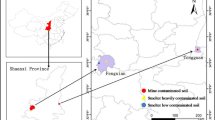Abstract
Purpose
The aim of the research was to determine the potential of dissolved humic substances extracted from leonardite to mobilize Cu and Pb from multi-metal contaminated soils with the scope of finding an efficient washing solution as a possible substitute for conventional washing agents used to extract heavy metals from polluted soils around mining areas.
Materials and methods
The efficiency of dissolved humic substances extracted from leonardite to extract Cu and Pb from multi-metal contaminated soil collected from “Larga de Sus” mine (Romania) was determined under batch conditions by single-step extraction. All extraction experiments were conducted in a stirrer with orbital rotation-oscillation and thermostat cupola at 100 oscillations/min and oscillation amplitude of 32 mm. The influence of stirring time (120, 240, 360, 720, 1440, 2400 min), concentration of humic solution (2% and 5%), and soil:solution ratio (mass:volume (m/V)) of 1:8, 1:10, and 1:16 on the Cu and Pb removal efficiency was investigated. The heavy metal concentration from soil and extractant solution was determined through atomic absorption spectrometry.
Results and discussion
The Cu and Pb removal process from soil using dissolved humic substances proceeded relatively quickly. In investigated experimental conditions, the best Cu and Pb removal efficiencies were observed after 360 min of stirring when 60.3% of Cu and 48% of Pb were extracted from soil (2% humic washing solution). The removal efficiency of Cu increased with increasing the soil:solution ratio and humic solution concentration, at shorter stirring times. In the case of Pb, an important improvement of the mobilization with an increasing soil:solution ratio or humic solution concentration was not observed, along with investigated stirring time. A soil:solution ratio of 1:8 was sufficient to reduce the Cu concentration in the studied soil below the intervention threshold established by Romanian legislation, after 360 min of stirring.
Conclusions
The mobilization of Cu and Pb from multi-metal contaminated soil using dissolved humic substances is strongly dependent on stirring time, soil:solution ratio, and concentration of humic washing solution. Nevertheless, the results of the present study demonstrate that dissolved humic substances extracted from leonardite are fairly effective washing agents for soils polluted with Cu, Pb, multiple heavy metals, and other pollutants in high concentrations.










Similar content being viewed by others
References
Ali M, Mindari W (2016) Effect of humic acid on soil chemical and physical characteristics of embankment. MATEC Web Conf. https://doi.org/10.1051/matecconf/20165801028
Babau M, Micle V, Damian GE, Varvara S (2017) Health risk assessment analysis in two highly polluted mining areas from Zlatna (Romania). J Environ Prot Ecol 18:1416–1424
Bahemmat M, Farahbakhsh M, Kianirad M (2016) Humic substances-enhanced electroremediation of heavy metals contaminated soil. J Hazard Mater 312:307–318
Boechat CL, Pistoia VC, Ludtke AC, Gianello C, Camargo FAO (2016) Solubility of heavy metals/metalloid on multi-metal contaminated soil samples from a gold ore processing area: effects of humic substances. Rev Bras Cienc Solo 40:0150383 https://doi.org/10.1590/18069657rbcs20150383
Borggaard OK, Hansen HCB, Holm PE, Jensen JK, Rasmussen SB, Sabiene N, Steponkaite L, Strobel BW (2009) Experimental assessment of using soluble humic substances for remediation of heavy metal polluted soils. Soil Sediment Contam 18:369–382
Conte P, Agretto A, Spaccini R, Piccolo A (2005) Soil remediation: humic acids as natural surfactants in the washings of highly contaminated soils. Environ Pollut 135:515–522
Erdogan S, Baysal A, Akba O, Hamamci C (2007) Interaction of metals with humic acid isolated from oxidized coal. Pol J Environ Stud 16:671–675
Gusiatin ZM (2018) Novel and eco-friendly washing agents to remove heavy metals from soil by soil washing. Environ Anal Ecol Stud 2(2):1–4
Gusiatin ZM, Kulikowska D, Klik B (2017) Suitability of humic substances recovered from sewage sludge to remedy soils from a former As mining area – a novel approach. J Hazard Mater 338:160–166
Huculak-Mączka M, Hoffmann J, Hoffmann K (2018) Evaluation of the possibilities of using humic acids obtained from lignite in the production of commercial fertilizers. J Soils Sediments 18:2868–2880
Karachaliou T, Protonotarios V, Kaliampakos D, Ariamenegaki M (2016) Using risk assessment and management approaches to develop cost-effective and sustainable mine waste management strategies. Recycling 1:328–342
Keri AA, Avram S, Rusu T (2010) Characteristics regarding the geomorphological change of land at the Larga de Sus Mine, the Zlatna Mining Perimeter, the County of Alba. ProEnvironment 3:318–321
Khalid AH, Alquzweeni SS, Modhloom HM (2015) Removal of copper ions from contaminated soil by enhanced soil washing. Int J Environ Res 9(4):1141–1146
Klucakova M (2012) Comparative study of binding behaviour of Cu (II) with humic acid and simple organic compounds by ultrasound spectrometry. Open Colloid Sci J 5:5–12
KluIáková M, Pavlíková M (2017) Lignitic humic acids as environmentally-friendly adsorbent for heavy metals. Journal of Chemistry. https://doi.org/10.1155/2017/7169019
Kulikowska D, Gusiatin ZM, Bułkowska K, Klik B (2015a) Feasibility of using humic substances from compost to remove heavy metals (Cd, Cu, Ni, Pb, Zn) from contaminated soil aged for different periods of time. J Hazard Mater 300:882–891
Kulikowska D, Gusiatin ZM, Bułkowska K, Kierklo K (2015b) Humic substances from sewage sludge compost as washing agent effectively remove Cu and Cd from soil. Chemosphere 136:42–49
Lestan D, Luo C, Li X (2008) The use of chelating agents in the remediation of metal-contaminated soils: a review. Environ Pollut 153:3–13
Li Y, Lei M, Chen T, Zhou X, Yang J, Wang Y (2012) Comparison of extractants for removing cationic metals and anionic metal from contaminated soil of the iron and steel work site. Disaster Adv 4(S1):3–9
Li Y, Lei M, Chen T, Yang J, Zhou X, Wang Y (2013) Optimized EDTA washing procedure to decontaminate heavy metals from soils in iron and steel works sites. Asian J Chem 25:37–41
Meng F, Yuan G, Wei J, Bi D, Ok YS, Wang H (2017) Humic substances as a washing agent for Cd-contaminated soils. Chemosphere 181:461–467
Mohanty B, Mahindrakar AB (2011) Removal of heavy metal by screening followed by soil washing from contaminated soil. Int J Technol Eng Syst (IJTES) 2(3):290–293
Moutsatsou A, Gregou M, Matsas D, Protonotarios V (2006) Washing as a remediation technology applicable in soils heavily polluted by mining metallurgical activities. Chemosphere 63:1632–1640
Order No. 756 of November 3, 1997 for the Approval of the Regulation on Environmental Pollution Assessment. Eminent: Ministry of Waters, Forests and Environmental Protection. (Published in: Official Gazette No 303 bis of 6 November 1997). http://legislatie.just.ro/Public/DetaliiDocumentAfis/151788 (in romanian). Accessed 20 August 2018
Orsetti S, Quiroga MM, Andrade EM (2006) Binding of Pb (II) in the system humic acid/goethite at acidic pH. Chemosphere 65:2313–2321
Reyes A, Fuentes B, Letelier MV, Cuevas J (2017) Mobilization of arsenic and heavy metals from polluted soils by humic acid. Geophysical Research Abstracts, 19th E G U General Assembly proceedings from the conference held 23–28 April, 2017 in Vienna, Austria, p.12092 2017EGUGA..1912092R
Shaker MA, Albishri HM (2014) Dynamics and thermodynamics of toxic metals adsorption onto soil-extracted humic acid. Chemosphere 111:587–595
Soleimani M, Hajabbasi MA, Afyuni M, Akbar S (2010) Comparison of natural humic substances and synthetic ethylenediaminetetraacetic acid and nitrilotriacetic acid as washing agents of a heavy metal-polluted soil. J Environ Qual 39:855–862
Steponkaite L, Sabiene N, Hansen HCB, Borggaard OK (2008) Mobilisation of Cu from soils by dissolved natural and processed humic substances. EKOLOGIJA 54(2):88–92
Szanto M (2012) Studies and research on the extraction by soil washing of heavy metals from polluted soils. PhD Thesis, Technical University of Cluj Napoca
Wang P, Li J, Wang H (2013) Engineering properties of heavy metal contaminated soil affected by EDTA washing. Electron J Geotech Eng 18:3809–3918
Weber J, Chen Y, Jamroz E, Miano T (2018) Preface: humic substances in the environment. J Soils Sediments 18:2665–2667
Wuana RA, Okieimen FE, Imborvungu JA (2010) Removal of heavy metals from a contaminated soil using organic chelating acids. Int J Environ Sci Technol 7(3):485–496
Xu J, Tan W, Xiong J, Wang M, Fang L, Koopal LK (2016) Copper binding to soil fulvic and humic acids: NICA-Donnan modeling and conditional affinity spectra. J Colloid Interface Sci 473:141–151
Yel E, Ahmetli G (2015) Environmental dilemma of humic substances: being adsorbents and being carcinogens. Int J Environ Sci Dev 6(1):73–76
Yang T, Hodson ME (2019) Investigating the use of synthetic humic-like acid as a soil washing treatment for metal contaminated soil. Sci Total Environ 647:290–300
Acknowledgments
Special thanks are given to the sales team of S.C. Semplant Romhol S.R.L Company (Bucharest, Romania) and Humintech GmbH Company (Grevenbroich, Germany), for supplying the humic substances extracted from leonardite (commercially available as Powhumus WSG-85).
Author information
Authors and Affiliations
Corresponding author
Additional information
Responsible editor: Xilong Wang
Publisher’s note
Springer Nature remains neutral with regard to jurisdictional claims in published maps and institutional affiliations.
Rights and permissions
About this article
Cite this article
Damian, G.E., Micle, V. & Sur, I.M. Mobilization of Cu and Pb from multi-metal contaminated soils by dissolved humic substances extracted from leonardite and factors affecting the process. J Soils Sediments 19, 2869–2881 (2019). https://doi.org/10.1007/s11368-019-02291-w
Received:
Accepted:
Published:
Issue Date:
DOI: https://doi.org/10.1007/s11368-019-02291-w




